Fiches poissons (page 3)
Page 3 des 2657 espèces de Poissons avec 60 fiches. Il y a 17 genres différents de Allotoca à Amphiprion.
Liste des fiches de Allotoca dugesii à Amphiprion clarkii
- Allotoca dugesii

6,0 → 8,0 cm (> 80 L)
pH 7,0–8,0 | GH 8–20 | 20–24°C - Allotoca goslinei

3,0 → 5,0 cm (> 120 L)
pH 7,0–7,5 | GH 5–12 | 16–28°C - Alopias vulpinus
 Requin-renard commun
Requin-renard commun
300,0 → 600,0 cm - Alosa fallax
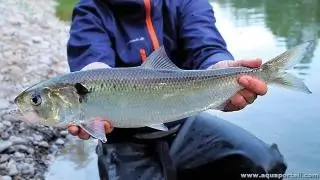 Alose feinte
Alose feinte
30,0 → 60,0 cm (> 6000 L)
pH 8,0–8,5 | GH | 5–26°C - Alosa pseudoharengus
 Gaspareau
Gaspareau
15,0 → 40,0 cm (> 6000 L)
pH 8,0–8,5 | GH | 4–28°C - Alosa sapidissima
 Alose savoureuse
Alose savoureuse
50,0 → 76,0 cm (> 6000 L)
pH 8,0–8,5 | GH | 5–25°C
- Altolamprologus calvus
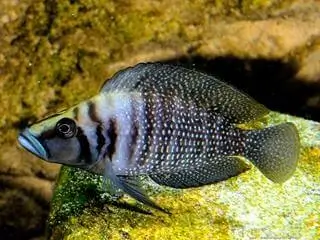 Cichlidé chauve
Cichlidé chauve
10,0 → 14,0 cm (> 300 L)
pH 7,5–9,0 | GH 8–30 | 24–27°C - Altolamprologus compressiceps
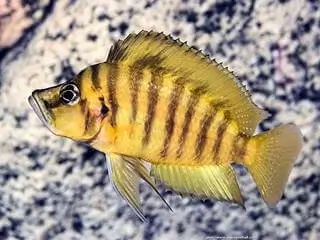 Cichlidé comprimé
Cichlidé comprimé
10,0 → 15,0 cm (> 300 L)
pH 7,5–9,0 | GH 8–30 | 24–28°C - Amatitlania altoflava

8,0 → 9,0 cm (> 300 L)
pH 6,5–7,5 | GH 3–8 | 23–28°C - Amatitlania kanna

8,0 → 9,0 cm (> 120 L)
pH 7,0–7,5 | GH 10–25 | 23–27°C - Amatitlania myrnae

7,0 → 10,0 cm (> 120 L)
pH 7,0–8,5 | GH 15–30 | 23–26°C - Amatitlania nanolutea

4,5 → 6,5 cm (> 80 L)
pH 7,0–8,0 | GH 8–20 | 22–27°C - Amatitlania nigrofasciata
 Cichlidé zèbre
Cichlidé zèbre
8,0 → 12,0 cm (> 120 L)
pH 7,0–8,0 | GH 10–20 | 20–36°C - Amatitlania nigrofasciata var. Marble

8,0 → 13,0 cm (> 200 L)
pH 6,5–7,5 | GH 5–15 | 22–29°C - Amatitlania sajica
 Cichlidé à barre en T
Cichlidé à barre en T
8,0 → 12,0 cm (> 120 L)
pH 6,5–7,5 | GH 5–20 | 22–30°C - Amatitlania septemfasciata
 Cichlidé à sept bandes
Cichlidé à sept bandes
10,0 → 13,0 cm (> 200 L)
pH 6,5–7,5 | GH 5–15 | 21–27°C - Amatitlania siquia
 Cichlidé avocat
Cichlidé avocat
7,0 → 9,5 cm (> 120 L)
pH 7,0–8,5 | GH 10–30 | 22–28°C - Amatitlania sp. Honduran Red Point

8,0 → 12,0 cm (> 200 L)
pH 7,0–8,0 | GH 8–20 | 22–30°C - Ambassis interrupta
 Perche de verre à longues épines
Perche de verre à longues épines
7,0 → 10,5 cm (> 200 L)
pH 7,0–8,0 | GH 8–30 | 26–32°C - Ambastaia nigrolineata
 Loche à lignes noires
Loche à lignes noires
6,0 → 8,0 cm (> 120 L)
pH 6,5–7,5 | GH 3–10 | 15–25°C - Ambastaia sidthimunki
 Loche naine, Botia sidthimunki
Loche naine, Botia sidthimunki
4,5 → 5,5 cm (> 120 L)
pH 6,0–7,5 | GH 3–12 | 22–30°C - Amblydoras nauticus
 Poisson-chat épineux
Poisson-chat épineux
6,0 → 7,5 cm (> 200 L)
pH 5,0–7,5 | GH 3–15 | 23–27°C - Amblyeleotris aurora
 Gobie symbiotique magnifique
Gobie symbiotique magnifique
9,0 → 11,0 cm (> 80 L)
pH 8,0–8,5 | GH | 23–28°C - Amblyeleotris diagonalis
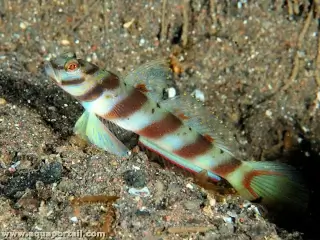 Gobie diagonal
Gobie diagonal
9,0 → 11,0 cm (> 120 L)
pH 8,0–8,5 | GH | 22–26°C
- Amblyeleotris guttata
 Gobie grimé
Gobie grimé
8,0 → 11,0 cm (> 120 L)
pH 8,0–8,5 | GH | 23–28°C - Amblyeleotris harrisorum
 Gobie à bandes jaunes
Gobie à bandes jaunes
7,0 → 10,0 cm (> 120 L)
pH 8,0–8,5 | GH | 23–28°C - Amblyeleotris latifasciata

11,0 → 13,0 cm (> 200 L)
pH 8,0–8,5 | GH | 23–28°C - Amblyeleotris randalli
 Gobie symbiotique de Randall
Gobie symbiotique de Randall
10,0 → 12,0 cm (> 120 L)
pH 8,0–8,5 | GH | 23–28°C - Amblyeleotris wheeleri
 Gobie splendide
Gobie splendide
5,0 → 6,5 cm (> 50 L)
pH 8,0–8,5 | GH | 23–28°C - Amblyeleotris yanoi
 Gobie drapeau
Gobie drapeau
6,0 → 12,0 cm (> 120 L)
pH 8,0–8,5 | GH | 23–28°C - Amblygobius albimaculatus
 Gobie tacheté blanc
Gobie tacheté blanc
12,0 → 18,0 cm (> 200 L)
pH 8,0–8,5 | GH | 23–28°C - Amblygobius bynoensis

8,0 → 10,0 cm (> 200 L)
pH 8,0–8,5 | GH | 23–28°C - Amblygobius decussatus
 Gobie à bandes oranges
Gobie à bandes oranges
6,0 → 9,0 cm (> 200 L)
pH 8,0–8,5 | GH | 23–28°C - Amblygobius phalaena
 Gobie à taches blanches, gobie annelé
Gobie à taches blanches, gobie annelé
12,0 → 15,0 cm (> 450 L)
pH 8,0–8,5 | GH | 23–28°C - Ameca splendens
 Améca brillante
Améca brillante
8,0 → 12,0 cm (> 120 L)
pH 6,5–8,0 | GH 10–30 | 23–29°C - Ameiurus catus
 Poisson-chat blanc
Poisson-chat blanc
30,0 → 95,0 cm (> 6000 L)
pH 6,5–8,5 | GH 10–30 | 2–30°C - Ameiurus melas
 Poisson-chat commun, Barbotte noire
Poisson-chat commun, Barbotte noire
25,0 → 60,0 cm (> 1500 L)
pH 5,5–8,0 | GH 3–25 | 8–30°C - Ameiurus nebulosus
 Barbotte brune
Barbotte brune
25,0 → 55,0 cm (> 6000 L)
pH 6,0–8,0 | GH | 2–36°C - Amia calva
 Poisson-castor
Poisson-castor
60,0 → 90,0 cm (> 1500 L)
pH 6,0–7,5 | GH 5–25 | 15–24°C - Ammocryptocharax elegans
 Characin caméléon
Characin caméléon
2,8 → 3,3 cm (> 20 L)
pH 5,0–6,5 | GH 1–5 | 23–27°C - Amphichaetodon howensis

15,0 → 18,0 cm (> 450 L)
pH 8,0–8,5 | GH | 20–25°C - Amphilophus amarillo

14,0 → 20,0 cm (> 450 L)
pH 6,0–7,5 | GH 5–12 | 24–29°C - Amphilophus citrinellus
 Citrinellum
Citrinellum
20,0 → 30,0 cm (> 1500 L)
pH 7,0–8,0 | GH 10–30 | 23–33°C - Amphilophus hogaboomorum

20,0 → 33,0 cm (> 800 L)
pH 7,0–8,5 | GH 5–25 | 25–34°C - Amphilophus istlanus

20,0 → 30,0 cm (> 800 L)
pH 7,0–8,0 | GH 5–15 | 26–32°C - Amphilophus labiatus
 Diable rouge
Diable rouge
22,0 → 30,0 cm (> 800 L)
pH 7,0–8,0 | GH 5–20 | 24–28°C - Amphilophus lyonsi

12,0 → 16,0 cm (> 800 L)
pH 7,0–8,0 | GH 1–15 | 25–29°C - Amphilophus trimaculatus

25,0 → 36,0 cm (> 1500 L)
pH 6,5–7,0 | GH 3–8 | 25–30°C - Amphilophus xiloaensis

14,0 → 16,0 cm (> 450 L)
pH 6,0–7,5 | GH 5–12 | 23–27°C - Amphilophus zaliosus

18,0 → 22,0 cm (> 450 L)
pH 6,0–7,5 | GH 5–12 | 23–28°C - Amphiprion akallopisos
 Poisson-clown sans parure, Moufette
Poisson-clown sans parure, Moufette
9,0 → 11,0 cm (> 120 L)
pH 8,0–8,5 | GH | 23–28°C - Amphiprion akindynos
 Poisson-clown de la barrière de corail
Poisson-clown de la barrière de corail
7,0 → 11,0 cm (> 80 L)
pH 8,0–8,5 | GH | 23–28°C - Amphiprion allardi
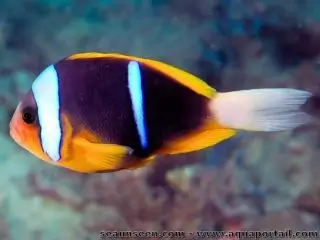 Poisson-clown d'Allard
Poisson-clown d'Allard
10,0 → 15,0 cm (> 300 L)
pH 8,0–8,5 | GH | 23–28°C - Amphiprion barberi
 Poisson-clown de Barber
Poisson-clown de Barber
7,0 → 9,0 cm (> 120 L)
pH 8,0–8,5 | GH | 23–28°C - Amphiprion biaculeatus
 Poisson-clown épineux
Poisson-clown épineux
9,0 → 18,0 cm (> 300 L)
pH 8,0–8,5 | GH | 23–28°C - Amphiprion bicinctus
 Poisson-clown à deux bandes
Poisson-clown à deux bandes
11,0 → 14,0 cm (> 120 L)
pH 8,0–8,5 | GH | 23–28°C - Amphiprion chagosensis
 Poisson-clown de Chagos
Poisson-clown de Chagos
9,0 → 11,0 cm (> 120 L)
pH 8,0–8,5 | GH | 23–28°C - Amphiprion chrysogaster
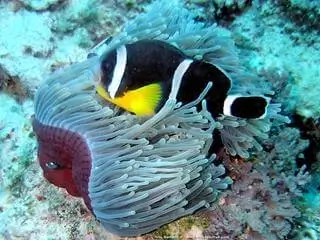 Poisson-clown de l'île Maurice
Poisson-clown de l'île Maurice
10,0 → 14,0 cm (> 200 L)
pH 8,0–8,5 | GH | 23–28°C - Amphiprion chrysopterus
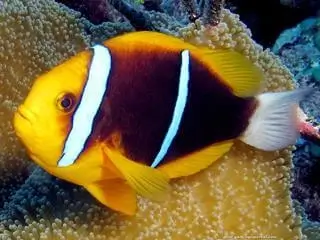 Poisson-clown à nageoires orange
Poisson-clown à nageoires orange
12,0 → 15,0 cm (> 300 L)
pH 8,0–8,5 | GH | 23–28°C - Amphiprion clarkii
 Poisson-clown de Clark
Poisson-clown de Clark
9,0 → 13,0 cm (> 200 L)
pH 8,0–8,5 | GH | 23–28°C
Les données biologiques des espèces indiquent la taille en cm et, si les valeurs sont pertinentes, d'autres caractéristiques spécifiques.
